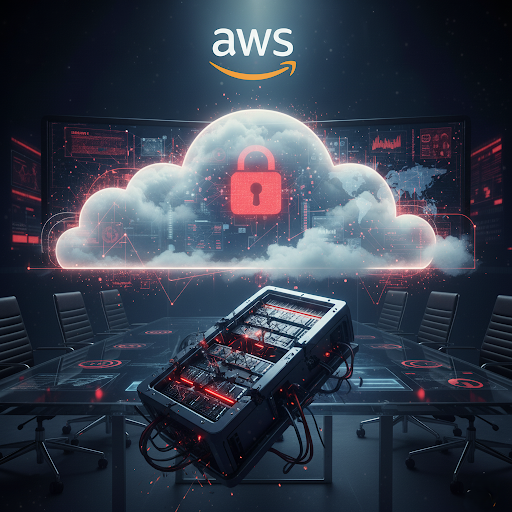On October 20, 2025, Amazon Web Services (AWS)—the backbone of nearly a third of the global internet—suffered a widespread outage that disrupted over 1,000 companies and impacted millions of users worldwide. From banks like Lloyds and Halifax to consumer platforms such as Snapchat, Reddit, and even government services like HMRC, the ripple effects were immediate and severe.
For executives, this was more than a technical hiccup. It was a stark reminder that cloud dependency is now a systemic business risk. The outage underscored a hard truth: resilience is not about preventing disruption altogether, it’s about preparing for the inevitability of disruption and ensuring continuity when it happens.
The AWS Outage: A Case Study in Systemic Risk
The AWS outage was triggered by a DNS resolution failure in AWS’s US-East-1 region, its largest and oldest data hub. While the technical cause may sound mundane, the consequences were instant and unforgiving.
- Scope of Impact: More than 11 million outage reports were logged across services.
- Critical Sectors Affected: Financial services, airlines, healthcare platforms, and consumer apps all experienced downtime.
- Global Reach: Even businesses not directly hosted on AWS were affected due to dependencies on AWS-powered third-party services.
This incident illustrates a systemic vulnerability: when a single cloud provider falters, the blast radius extends far beyond its direct customers.
Why Executives Should Care: Strategic Implications
For business leaders, the AWS outage is not just a technology story, it’s a governance and strategy story. The implications are profound:
- Operational Continuity at Risk
- Outages can halt customer transactions, disrupt supply chains, and paralyze internal systems.
- Even short disruptions can erode customer trust and trigger financial losses.
- Reputational Damage
- In the age of social media, outages become headlines within minutes.
- Customers rarely distinguish between a vendor’s failure and your brand’s accountability.
- Regulatory and Compliance Exposure
- For regulated industries like finance and healthcare, outages can compromise compliance obligations, audit trails, and data integrity.
- Concentration Risk
- Heavy reliance on a single cloud provider creates a single point of failure.
- Executives must treat cloud dependency as a strategic concentration risk, akin to over-reliance on a single supplier.
Lessons in Business Resilience
1. Cloud Dependency Requires Board-Level Oversight
Cloud strategy is no longer a technical decision—it’s a boardroom issue. Executives must ensure that cloud reliance is explicitly addressed in enterprise risk management frameworks.
Action Point:
- Establish board-level reporting on cloud concentration risk.
- Integrate cloud outage scenarios into enterprise risk assessments and business continuity planning.
2. Redundancy Is Not Optional
The AWS outage revealed that many businesses had not adequately implemented multi-region or multi-cloud redundancy.
Action Point:
- Architect critical workloads across multiple regions and, where feasible, multiple providers (AWS, Azure, Google Cloud).
- Prioritize redundancy for customer-facing systems, payment platforms, and mission-critical operations.
3. Third-Party Risk Is Your Risk
Even if your systems are not hosted on AWS, your vendors, partners, or SaaS providers likely are.
Action Point:
- Conduct a third-party dependency audit to map which vendors rely on AWS or other single points of failure.
- Require vendors to demonstrate resilience strategies, including failover capabilities and tested continuity plans.
4. Incident Response Must Be Enterprise-Wide
The outage highlighted the importance of coordinated response across IT, communications, legal, and executive leadership.
Action Point:
- Develop cross-functional incident response playbooks that include communication strategies for customers, regulators, and investors.
- Rehearse outage scenarios through tabletop exercises at least twice annually.
5. Communication Is as Critical as Recovery
During the outage, many businesses struggled not only with downtime but with customer frustration fueled by silence or vague updates.
Action Point:
- Prepare pre-approved communication templates for outages.
- Ensure transparency: acknowledge the issue, outline steps being taken, and provide realistic timelines for recovery.
Building Forward-Looking Resilience
Embrace a “Resilience by Design” Mindset
Resilience cannot be bolted on after the fact. It must be embedded into architecture, governance, and culture.
- Architectural Resilience: Design systems with failover, redundancy, and modularity.
- Operational Resilience: Train teams to operate under degraded conditions.
- Cultural Resilience: Foster a mindset where disruption is expected and adaptability is rewarded.
Invest in Scenario Planning
Businesses must move beyond generic risk registers and engage in scenario-driven planning.
- What happens if AWS goes down for 24 hours?
- How would your business operate if your payment processor is unavailable for a week?
- What reputational risks arise if customers cannot access your services during a high-demand period?
Rethink Cyber Insurance and Contracts
The AWS outage raises questions about coverage and liability. Many cyber insurance policies exclude outages caused by third-party providers.
Action Point:
- Review insurance policies for cloud-related exclusions.
- Negotiate contracts with cloud providers and vendors to clarify responsibilities during outages.
Turning Crisis into Catalyst
The AWS outage was not an anomaly, it was a preview of the systemic risks inherent in today’s digital economy. For executives, the lesson is clear: resilience is no longer a technical aspiration; it is a strategic necessity.
Leaders who treat cloud dependency as a governance issue, invest in redundancy, and embed resilience into culture and operations will not only weather future outages but also gain competitive advantage. Those who fail to adapt risk being remembered not for their products or services, but for the day their business went dark.
The question for every leader is no longer if you are prepared, but what your business will look like when you are the only one left standing.
Ready to build a resilience strategy that keeps your business steady when others falter? Our team helps you stay ahead of crises.
